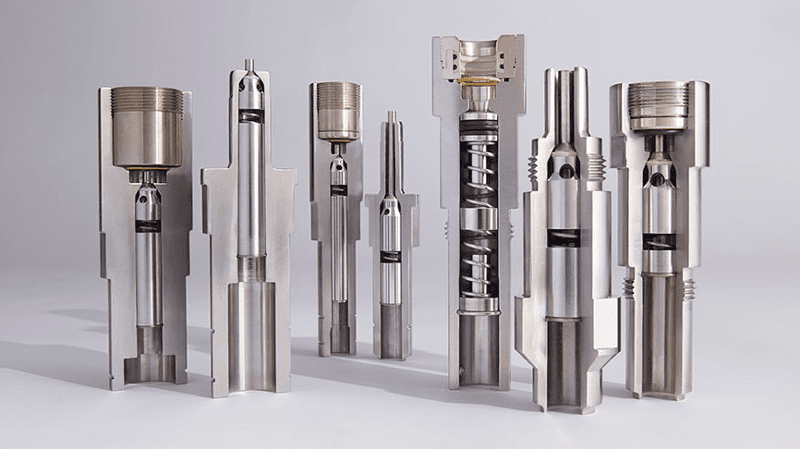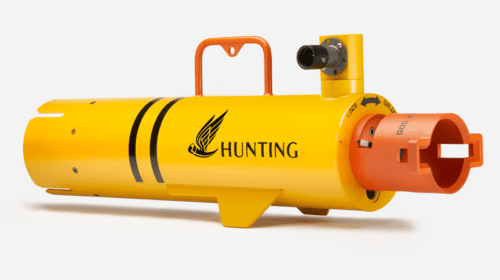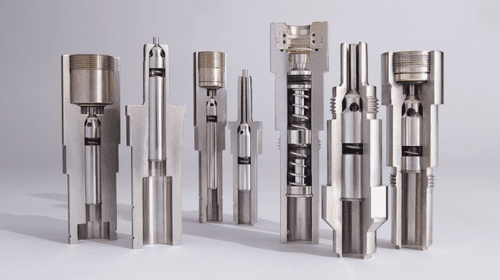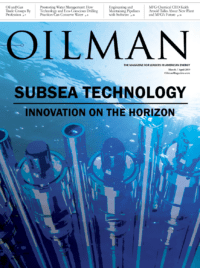A test question for third graders studying about the universe asked what color the Earth appeared from space and why. The answer to this question is simple to an adult, it’s a widely known fact. It’s blue. The Earth from space appears blue, as it primarily covered by water – approximately 71 percent of it, in fact. It is one of the most important substances on Earth and absolutely necessary for survival. However, within the oceans’ seabeds lies one of Earth’s most important natural resources. In these bodies of water all over the world, are vital structures put into place for supplying a large portion of the world’s oil and natural gas. The role that the drilling rig and platform perform in that water, along with the components that are housed within it, are invaluable to the success of this industry. The complexity of their makeup is fascinating and although they’ve been in existence over 80 years, the technology making them more efficient, is changing and progressing every day.
Hunting Energy Services has played an integral role in the worldwide offshore energy sector for over fifty years. Their Subsea Technologies division is in Stafford, Texas, located about 20 miles southwest of Houston. Within their facility, they design and manufacture essential hydraulic subsea equipment that is specifically created for and used by customers across the globe. They have some exciting things on the horizon that are being developed to meet industry and customer demand. Their team has been and continues to work feverishly on new designs and ideas, while at the same time working on adding improvement and variety to the staples they’ve built their reputation on for years. Fortunately enough, they were able to sit down and meet with OILMAN to share their enthusiasm about the revolutionary and exciting things coming down the line.
Couplings
With over two million installed, hydraulic couplings are Hunting’s Subsea Technologies’ main product offering. Impressively, there are no reported field failures to date attributable to a design flaw – a testament to the careful planning used to create the thousands of designs in their catalog. 10KSI and 15KSI couplings are commonplace, but Hunting has pushed the bar; their newest product is the 20KSI coupling. “We recently finished qualifying 20KSI tree couplings. The main challenge was to marry an increased pressure rating along with increased allowances for misalignment and side-loading. All of these enhancements were in response to customer requests as they continuously work to meet greater challenges. We are now in the process of developing 20KSI plate couplings, moving forward with an even higher side-load capacity,” says Scott Stolle, Coupling Engineering Supervisor. 20KSI couplings are employed in subsea deepwater, high pressure oil and gas systems where hydraulic control and chemical injection systems are required. The coupling development is for use in Christmas Trees (XT) and Tubing Hangers (TH), and it includes features that allow larger misalignments between mating equipment. These misalignments induce side loads between coupling pairs that are beyond the capabilities of previous equipment. These couplings are also designed to meet API 17F requirements for mating speeds at 0.5 m/s. Another unique feature of the 20KSI XT couplings are the metal seals, which withstand both internal and external (subsea environmental) pressure.
Another innovative coupling design is the Soft Seal Hydraulic Coupling. Although the coupling itself is not new to the industry, Hunting has developed a polymer seal female coupling that is interchangeable with a metal seal female. The soft seal coupling is designed to lower cost and allows stab plates/control systems to be configured with soft seal and metal seal couplings all in one plate. Soft seal couplings are a reduced-cost solution permitted for certain applications. This is cost-effective to the consumer because it keeps them from having to purchase several different types of males to adapt to a specific female coupling.
With more than 3,500 different male and female coupling designs, they serve in a wide range of applications due to their custom tailored design characteristics. The applications vary from low-pressure, shallow water connections to the most critical component of HPHT and ultra-deepwater systems. Their personnel are available to assist in the engineering and design of couplings for special applications.
Metal Seal Couplings
RS Series: The RS-Series compact hydraulic coupling line is designed for tubing hanger penetrator and subsea ROV flying-lead connector applications where reduced size, weight, separating loads and travel distances are critical requirements.
UO Series: The UO-Series hydraulic coupling line answers market demands for a smaller, lighter and higher flow coupler for extreme working pressures in ultra deepwater.
TO Series: The TO-Series hydraulic coupling line was developed for deepwater applications, requiring the highest possible reliability, under the most severe working pressures.
RO Series: The RO-Series hydraulic coupling line is for hot stab diver or ROV make-up applications, used for subsea trees, control pods, manifolds and chemical injection.
TM Series: The TM-Series hydraulic coupling line is for both surface and subsea applications where manually threaded make-up connections are desired.
Elastomer Seal Couplings
AS Series: The AS-Series hydraulic coupling line is our highest pressure-rated elastomer seal coupling, designed for working pressures of up to 17,500 psi.
HCC Series: The HCC-Series hydraulic coupling line is for general economical purposes and low-pressure applications, generally utilized for hydraulic umbilical junction plates and is not recommended for subsea applications.
HO Series: The HO-Series hydraulic coupling line is designed for various intermediate pressure applications and primarily utilized for hydraulic umbilical junction plate tie-ins, power units and shallow water diver/ROV stab applications.
AO Series: The AO-Series hydraulic coupling line is designed for ease of seal replacement and adaptable to a wide range of applications, including flying lead connectors, umbilical terminations and subsea junction plate assemblies.
Hunting’s hydraulic couplings have been installed in subsea applications including, but not limited to:
- Subsea Trees
- Tubing Hanger Penetrators
- Production Control Systems
- Subsea Control Modules
- Drilling Control Systems
- ROV Hydraulic Flying Leads
- Chemical Injection Systems
- Installation/Workover Control Systems
- ROV Hot Stabs
Back Pressure Valve
Hunting offers several different kinds of valves, including drilling control valves and specialty valves. However, the one that has picked up a lot of steam in the last few years is their Back Pressure Valve. The valve is installed subsea on dedicated chemical injection lines supplied by topside metering pumps. “For wells with sub-ambient pressure, the chemical being injected tends to drain faster than the topside flow rate, which empties the supply line. Side effects include improper dosage, undesirable fluid properties, and even line collapse from hydrostatic pressure in the case of thermoplastic umbilicals,” said Josh Williams, Senior Technical Sales Engineer.
Weighing in at just five pounds, Hunting’s palm-sized BPV solves each of those issues by maintaining pressure in the supply line at a fixed value relative to hydrostatic pressure. Hundreds of wells currently feature the valve – primarily in the Gulf of Mexico, Brazil, and off the coast of Africa – with zero reported failures and some units subsea for over 10 years. Greenfield projects that are anticipated to become sub-ambient in the future, tend to incorporate the valve into a tree or logic cap, while brownfield projects have tended to install the valve into a cobra head. In one case study, Hunting’s compact valve prevented an Operator from replacing a multi-million-dollar thermoplastic umbilical subject to collapse in service of a sub-ambient well. The valve is automatically depth compensated with no field adjustment necessary. It is qualified for pressures to 15KSI, water depths to 15,000 feet, and flow rates up to 3 gallons per minute.
Chemical Injection Metering Valve
Hunting has redefined subsea chemical injection accuracy and performance with their CIMV (Chemical Injection Metering Valve). It provides subsea chemical injection metering for multiple well field developments with long offset distances from the host production facility. They have changed the game for deepwater and high differential pressure injection applications.
The CIMV is designed to reduce CAPEX costs by allowing chemical delivery to multiple injection points subsea from a single umbilical supply, and OPEX costs by delivering chemical to within 5 percent of the desired rate. With a maximum working pressure of 17.5KSI, a maximum differential pressure of 10KSI, and a maximum water depth rating of 15,000 feet, the Hunting CIMV is ready for tomorrow’s ultra-deep and high-pressure reservoirs. With the addition of a new linear sensor for the positive displacement flow meter, operator confidence is increased by providing instantaneous flow rate feedback and adjustment, and precisely delivering chemical regardless of varying pressure and fluid conditions, over a range of 2 gallons per minute down to 5 gallons per day. Further development is underway to increase the maximum working differential pressure to over 16KSI, increasing its utility in upcoming 20KSI tree projects.
The CIMV is exceptional because of the many benefits it offers. There are no filters required, multiple chemicals can be simultaneously delivered at controlled and verifiable injection rates, it can provide continuous chemical injection despite loss of host electrical power, and it is able to handle a wide variety of chemicals under a full range of differential pressures without regard to fluid properties.
Savings through Practicality
Customer satisfaction often comes from providing savings to the bottom line. Hunting is customer-focused to its core. They strive to not only satisfy the customer’s needs currently, but to also anticipate what their potential needs will be in the future. For instance, in designing a new product like the 20KSI coupling, they maintained the original footprint. They took existing technology and made it withstand higher pressure without redesigning the mounting interface. By doing it this way, it drives savings to the operator. The innovation satisfies and saves money at the same time. The same concept ultimately applies to the CIMV as well. Chemicals are very costly and by offering instantaneous feedback and dosage within +/- 5 percent of set point, it injects with such accuracy that there is little waste. Given that fields are commonly producing for 25-30 years, the savings add up over time.
Lifecycle Support
Over the years, Hunting has built a solid foundation within this industry and has obtained a reputation that keeps customers returning and new ones knocking at their door. From paper design through production, launch and into the lifespan of the product in the field – the support is constant. By strictly adhering to quality in every aspect of their operations, they provide the industry’s most reliable product solutions. They have teams of certified and knowledgeable technicians that are able to provide on-site services anywhere in the world, and the flexibility to respond quickly to service requests with the ability to mobilize a team within 24 hours.
Hunting’s field service capabilities include, but are not limited to the following:
- Assess damage of used hydraulic couplings.
- Replace hydraulic coupling seals.
- Help identify and resolve hydraulic coupling float issues on subsea stab plates.
- Inspect serviceability of flushing and testing plates.
- Service hydraulic couplings on umbilicals, semi-ridged jumpers, cobra heads, trees, pods and distribution manifolds.
- Replace hydraulic valve seals.
- Diagnose chemical injection metering valve (CIMV) issues.
- Assist with deployment and retrieval of subsea chemical injection metering valves (CIMV).
- Provide training courses on proper Hunting product use.
Weldment services also offer a high quality and warranted welded hydraulic coupling assembly that is installation-ready. Hunting currently has over 1,000 different welded assembly designs that have been used in a variety of subsea applications. Their welded assemblies are fully documented and tested to the most current NDT standards conducted by qualified and experienced technicians.
“Through the years, Hunting has continuously aligned our technical resources and capabilities to meet our customers’ needs, ultimately positioning them for success. Utilizing this focused alignment and synergistic approach, we have created incredible technological advances. Looking forward, as our industry continues to strengthen, cost effective technology driven solutions and customer satisfaction through innovation will be the foundation for Hunting’s Subsea business. We believe this platform will develop success for our customers in this difficult and competitive environment that we are faced with today” said Dane Tipton, Hunting Subsea Technologies President.
“Customer satisfaction through innovation” is their motto. After meeting their impressive team, absorbing their product knowledge and seeing first-hand the dedication they have to their customers, it’s probably not possible to get more accurate than that.
Sarah Skinner is a graduate of Louisiana State University with a degree in English. She has been a technical writer and editor in the oil and gas industry for over ten years in Houston and in Louisiana. She currently works as a technical writer for a pre-cast concrete construction company in Louisiana that builds blast-proof buildings for petrochemical plants.









